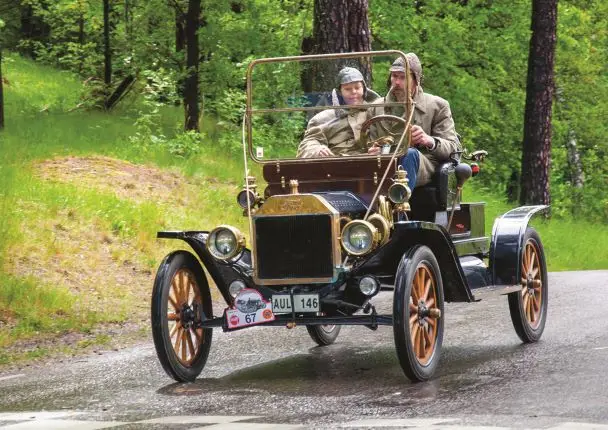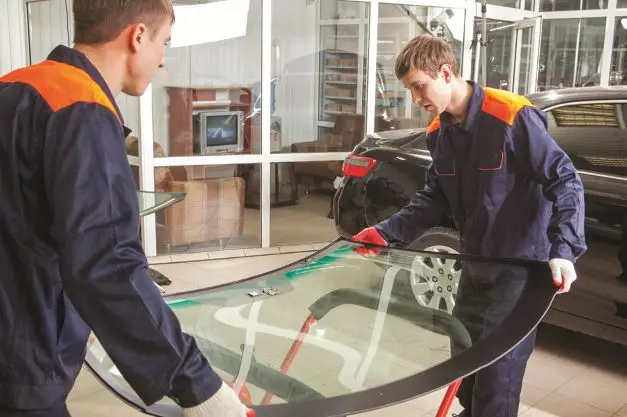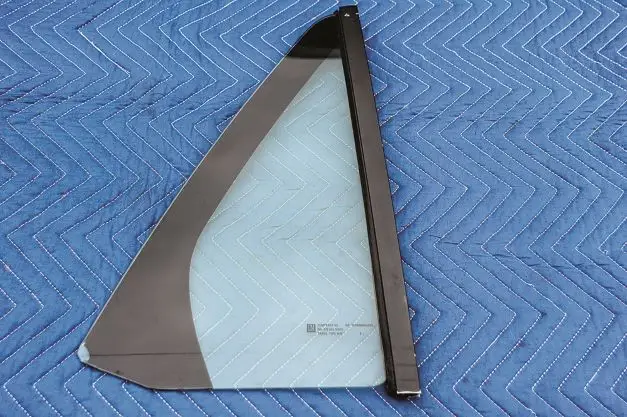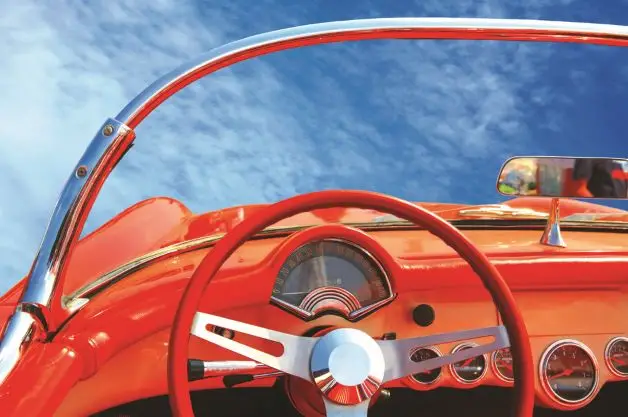The glass on today’s vehicles has features unheard of a few years ago.
by Vince Piva
Since its invention in Ancient Egypt way back in 3500 BCE, human beings have had a love affair with glass. Glass was a sought-after material for making cups, containers, and jewellery. This material reached the United States when the first North American glass was produced in Jamestown, Virginia, in 1608. But it took another 300 years before it was used on a motor vehicle. That was when Ford announced that its vehicles could be ordered with extras such as a windshield, a speedometer, and headlights—for an additional $100 above the standard price of $850. What a deal!
The glass used in these first windshields (called windscreens in Great Britain) was…just glass, the same single-paned glass used for the windows of a house. As you can imagine, anyone involved in a car accident could be severely injured or killed by flying pieces of glass. There is a story floating around that good old Henry Ford himself was injured by flying glass and this convinced him to look for a better type of glass.
A Better Glass
It took Ford 10 years to have a decent windshield produced. In 1919 a Ford employee started working with Pilkington, a British glass manufacturer, on a new glass process. Ford started to make its own glass in a facility close to the steel mill and car assembly line. By the end of 1919, Ford was using laminated glass, two glass sheets with a bonding agent in between. Later, laminated glass was introduced to all Ford vehicles.
" Henry would be proud of the development of the lowly windshield.”

At first, the medium used between the two glass sheets was cellulose. Also, the windshield was bonded to the frame by a new product called “urethane glue.” The strong bonding between the windshield and the frame gave additional strength to the structure of the car, offering extra protection to the driver and passengers in a rollover accident.
Unfortunately, two problems arose. First, the cellulose would discolour and darken, making vision somewhat impaired. Second, it would become brittle over time, so the windshield would puncture more easily. These problems were solved when a synthetic resin was invented—polyvinyl butyral (PVB). This process made the glass clearer and stronger. It also helped block high-frequency sound (improving soundproofing) and harmful ultraviolet (UV) rays emitted by the sun.
In 1938, PPG (Pittsburg Plate Glass) developed tempered glass, which was much more shatter-resistant than plate glass. It was much thinner than windshield glass and considerably cheaper to manufacture, making it ideal for side and back windows.
Laminated glass is still the standard for windshields, and tempered glass for the other windows. However, there is a move now to have laminated glass used for all windows, thus making vehicles safer.
A Better Standard
In the 1950s, cars were becoming behemoths, huge beasts made of steel and a lot of glass. Wraparound windshields and rear windows were the norm. This increased driver discomfort, as the car became an oven during the summer months, especially in the south. Also, privacy was compromised—it was like living in a glass house. The solution—tinting the windshield and windows—minimized these problems. The windshield was made with a small percentage of iron oxide, giving it a bluish/greenish tint. Also, a dye was introduced to the top PVB layer. In some cars, the top layer was bronze, which reflected much of the sun’s rays, thus improving the driver’s vision and also acting as a sunshade.
The 1970s were a big decade for car manufacturers. In the US, Federal Motor Vehicle Safety Standards were implemented, including FMVSS 205 for strength and clarity of laminated windshields, FMVSS 212 for windshield retention and strength during accidents, FMVSS 216 for roof rigidity in a rollover accident, and FMVSS 219 for limits on the penetration of the windshield by other objects.
At the same time, the National Highway Traffic Safety Administration (NHTSA) was founded. Every windshield manufactured in the United States or abroad must now have a Department of Transport (DOT) emblem embedded in it to verify that the vehicle meets safety standards.

"Today’s windshields are highly sophisticated compositions.”
Continued Innovation
Today’s windshields are highly sophisticated compositions of glass. Not only do they meet all the FMVSS, DOT, and NHTSA standards, but they also offer features unheard of a few years ago.
These features were common 10 years ago:
Low-E glass. Some manufacturers are producing a windshield made of low-E glass. This type of glass has a low emissivity of infrared rays emitted by the sun. A coating increases the windshield’s ability to reflect ultraviolet rays, preventing up to 25 percent of heat penetration. This keeps the interior of the cabin cooler, the air conditioner will not have to work as much, and this will reduce the vehicle’s emission of carbon dioxide.

Driver-controlled dimming glass. Another type of treated glass is found on the sun/moon roof of some European vehicles. This type of glass can be darkened or lightened by the turn of a switch, blocking from 1 percent to 50 percent of the sun’s rays
Water-repellent glass. Another coating is used by some manufacturers on side-view mirrors and door glass. This coating prevents water droplets from sticking to the glass. This technology is currently mainly applied in the aircraft industry, but there is talk that it may filter down to the automotive sector. Imagine having no need for windshield wipers!
Electro-thermal defogging glass. Mainly used on rear windows, this feature prevents window fogging during the fall and winter months. An electrical grid is embedded in, or glued to, the rear window and is connected to a switch the driver can turn on when the need arises. It will defog the window in a few minutes.
Heated windshield. Some vehicles have an electrical grid bonded to the windshield glass. When there is ice or snow on the glass, the driver does not need to scrape it. He/she will start the engine and then turn on a switch to defrost and de-ice the windshield in a few minutes.
Printed glass antennas. A grid is bonded to the windshield to improve radio reception and digital communication without compromising the aesthetics of the vehicle with protruding attachments.
Head-up display. This is a spin-off from the United States Air Force, where it is used to assist pilots when conducting sorties. Thanks to a small projector, the windshield becomes a complete dashboard, displaying all the information the pilot needs. The automotive industry will project only necessary information, enough to alert but not confuse the driver.
Electrically heated side-view mirrors. These mirrors are equipped with an electrical grid. When the grid is turned on, the mirror will heat up, and snow and ice will melt away. Also, the mirrors can change colour to protect the driver from excessive glare when a following car has its high beams turned on. This same feature is also available on rear-view mirrors, except they don’t need the de-icing part.
A new windshield has been developed in which the normal thickness of 4.5 mm has been reduced to 3.9 mm. This is a weight-saving device—reducing weight by about 1.4 kilograms per square metre. On top of that, the infrared reflected emissivity was bumped up to 40—only 40 percent of solar energy penetrates into the cabin, compared to the standard windshield, which has a number of 60.
Today’s windshields are smaller, stronger, and chemically treated, with embedded antennas, head-up displays, and many other features. I’m sure good old Henry did not know where laminating two pieces of glass together would lead and how it would change our driving habits. I bet he would be proud of the development of the lowly windshield.
I hope this technology doesn’t stop developing. Personally, I would like to see a time when all of the glass in a vehicle—windshield, side glass, and mirrors—is treated so that it doesn’t retain water and doesn’t get fogged up. It would make our life much easier and our driving much safer.

